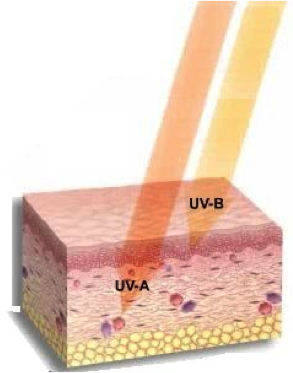Ultraviolet radiation (UV) may be invisible to the human eye, but its harmful effects are far from invisible. UV energy, whether produced by the sun or all forms of artificial lighting (incandescent, fluorescent, halogen, LED and induction) has a cumulative effect on our bodies, food and our possessions.
Ultraviolet radiation is present in three forms: UVC, UVB and UVA. UVC (200-280nm) produce the most energy and do the most damage to our skin. In nature, after they are emitted by the sun and head toward earth, they are absorbed in the earth’s outer atmosphere. UVB rays (280-315 nm) do the most damage to our body’s DNA structure and even inhibit DNA’s ability to repair itself. UVA (315-400nm) causes indirect DNA damage.
The same UVB rays emitted by the sun are also emitted by fluorescent lighting in homes, schools, workplaces; even in hospitals. UVB radiation causes sunburns, and damages the epidermal layer (surface) of the skin. 
UVA radiation penetrates deeper layers of the skin, the dermis layer, and is responsible for photo-aging. The effects of UV radiation are long term and cumulative. This means that the sunburn you received as a child can still be affecting your body’s DNA structure to this day! Both UVB and UVA radiation are capable of causing skin cancer.
The Harmful Effects of UV Rays Emitted By Fluorescent Lights
The autoimmune disease, Lupus Erythematosus (Lupus) currently affects 1.5 to 2 million people in the United States. It is estimated that 90% of Lupus patients are women, with a large number being African-American, Latina and Asian. It is more prevalent than sickle-cell anemia cerebral palsy, multiple sclerosis and cystic fibrosis combined. Lupus is a disease in which the body attacks its own healthy tissues and organs. It can damage the joints, skin, kidneys, and other parts of the body. Many of the symptoms of Lupus mimic other health conditions, (fatigue, skin rash, joint pain, low-grade fevers), so it can be difficult to diagnose. One of the environmental factors known to adversely affect Lupus is exposure to UV radiation.
There are over 150 commonly prescribed medications that can cause the human body to become sensitive to UV rays according to the FDA. One such medication is classified as an anti-malarial drug. This same drug is used to treat the symptoms of Lupus. Patients diagnosed with Lupus are especially susceptible to UV rays; some even reported weakness after standing beneath unfiltered fluorescent lighting for less than half an hour.
There are numerous scientific studies indicating UV exposure’s role in the cause of melanoma and non-melanoma cancers; cataract formation and immune system damage. Additionally, according to a study published in the American Journal of Epidemiology, unfiltered fluorescent light emits up to 10-30 times more UVB radiation than the sun (Walter, 1992).
Most hospitals utilize standard, cost-efficient fluorescent light bulbs that provide adequate lighting for physicians, patients and families. In order to provide a UV safe environment in the healthcare setting, the best solution is Naturalux™ Filters for fluorescent lighting. These filters are safe, affordable and they absorb 100% of UV rays up to 380nm. That means patients, healthcare providers, and family members are protected from all harmful UV rays emitted by fluorescent lighting.
Diffuser Specialist is the authorized International Distributor of Naturalux™ Filter products and is working to create UV safe environment in our hospitals. If you’re looking for a UV safe lighting solution contact us with any further inquiries or visit http://www.naturalux.com/ for more information about our UV safe filters.
References:
http://aje.oxfordjournals.org/
Walter, S. (1992). The association of cutaneous malignant melanoma and fluorescent light exposure.American Journal of Epidemiology, 135(7), 1-6. doi: http://aje.oxfordjournals.org/


